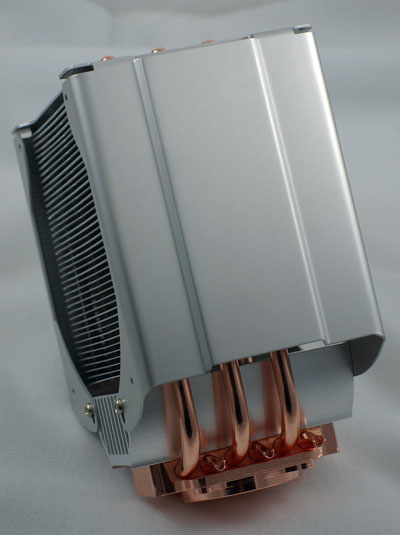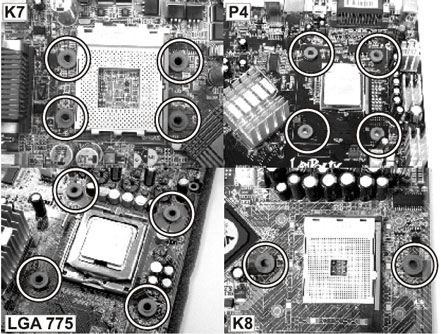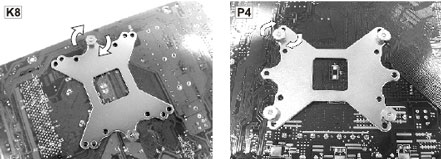Cooler Master Hyper 6+: Universal Heatpipe Tower
by Wesley Fink on February 14, 2007 12:02 AM EST- Posted in
- Cases/Cooling/PSUs
Cooler Master Hyper 6+
The Cooler Master package provides a good view of what you will get with the Hyper 6+. The cooler itself is featured in an acrylic clamshell that showcases the copper base, the aluminum heat fins, and the 6 heatpipes.

Cooler Master ships the Hyper 6+ with a 100mm fan, but it is not mounted. This allows you to clearly see a few of the tower design features

This includes the serrated fin design which significantly increases the surface area of the fins. The hybrid copper and aluminum base is also distinctive, using copper for the CPU plate and cast aluminum fins for first-stage cooling.

Heat is moved from the copper base to the fin tower with six copper heatpipes. The design mounts three pipes on each side of the tower and attaches the serrated fins to the heatpipes to remove heat.

Early designs of this cooler used a powerful and somewhat noisy 100mm fan. The current shipping fan does not move as much air but it is promoted as "Ultra Silent". A more powerful fan is available from Cooler Master if needed, but the odd 100mm fan-size makes finding other fans difficult. Standard sizes in this area are 92mm and 120mm.
Inside the box you will also find zip bag with the four adapter plates and the universal back plate. There is also a small bag of parts with the screws and washers needed to mount the fan, attach the adapter plate, and mount the cooler. Inside the bag you will also find a small packet of thermal compound and mounting instructions. The instructions are frankly awful. If some technical writer had just spent one paragraph describing the concept everything would have been much easier to mount.

Basically you choose the right adapter plate, attach the mount screw to the plate, turning counterclockwise to screw the upper part of the attachment screw to the adapter plate. You then screw the plate onto the cooling tower - around the round CPU plate - with the small countersunk screws.

The large and small washers or pads are misidentified in the instructions. We also found the use shown in the instructions was not the easiest. The large hole soft pads fit best around the screws that will go though the motherboard on the adapter plate. They have an adhesive side so they can stick and not move all over the place when you mount. We found this easier than placing the washer pads on the motherboard as suggested in the instructions.

After mounting the adapter and sticking on the large washers you apply thermal compound to the cooler copper plate and turn the motherboard upside down. The screws you attached to the adapter fit though the motherboard holes. Then place the other washers on the protruding screws, and attach the back plate - securing it with the provided nuts. There is also an included Phillips/flat blade nut driver that can be used with your screwdriver to attach the nuts on the bottom of the motherboard. The back plate is only needed for some CPU sockets, and Socket 775 is not one of them. However, it still fits on 775, and it still has mounting holes that will fit the 775 holes, so we used it to reinforce the board and further distribute the 2 pound weight of the Hyper 6+.
It is all but impossible to install this HSF on a partially mounted motherboard. The best way to attach the assembled HSF is to stand the Hyper 6+ on its top, lower the upside-down motherboard on the HSF, and secure the HSF from the back. Once you understand how the adapters and HSF work together installation is pretty easy. It would be even easier if the installation instructions clearly communicated this concept.
Specifications
Our test system is Intel Socket 775, but the Cooler Master Hyper 6+ will mount on a wide range of systems with various CPU sockets. All the needed hardware is included to fit the variety of supported sockets
As already mentioned, the Hyper 6+ is a bit smaller than the Tuniq Tower 120, which should allow it to fit in situations where the Tuniq is just a little tight. There should be no problem mounting it in most mini, mid, or full tower designs, or in most full desktop cases. However, micro ATX and Media Center cases may or may not be able to handle the Hyper 6+. It is big and you should measure carefully if you have a small case.
While the Hyper 6+ is a little smaller it still weighs about the same as a Tuniq Tower 120 when the fan is attached. That is it approaches a kilogram (2.2 lbs.) in weight. The back plate spreads the weight over a larger area, but this is still much heavier than either Intel or AMD recommend. Use caution if you plan to move your PC a lot - or choose a smaller, lighter weight design like the Scythe Katana, which is a much smaller and lighter heatpipe tower. The smaller designs do not cool quite as well but they are normally within manufacturer recommended weights and should be safer if you move your PC a lot - as in carrying it back and forth to LAN parties.
The Cooler Master package provides a good view of what you will get with the Hyper 6+. The cooler itself is featured in an acrylic clamshell that showcases the copper base, the aluminum heat fins, and the 6 heatpipes.

Cooler Master ships the Hyper 6+ with a 100mm fan, but it is not mounted. This allows you to clearly see a few of the tower design features

This includes the serrated fin design which significantly increases the surface area of the fins. The hybrid copper and aluminum base is also distinctive, using copper for the CPU plate and cast aluminum fins for first-stage cooling.

Heat is moved from the copper base to the fin tower with six copper heatpipes. The design mounts three pipes on each side of the tower and attaches the serrated fins to the heatpipes to remove heat.

Early designs of this cooler used a powerful and somewhat noisy 100mm fan. The current shipping fan does not move as much air but it is promoted as "Ultra Silent". A more powerful fan is available from Cooler Master if needed, but the odd 100mm fan-size makes finding other fans difficult. Standard sizes in this area are 92mm and 120mm.
Inside the box you will also find zip bag with the four adapter plates and the universal back plate. There is also a small bag of parts with the screws and washers needed to mount the fan, attach the adapter plate, and mount the cooler. Inside the bag you will also find a small packet of thermal compound and mounting instructions. The instructions are frankly awful. If some technical writer had just spent one paragraph describing the concept everything would have been much easier to mount.

Basically you choose the right adapter plate, attach the mount screw to the plate, turning counterclockwise to screw the upper part of the attachment screw to the adapter plate. You then screw the plate onto the cooling tower - around the round CPU plate - with the small countersunk screws.

The large and small washers or pads are misidentified in the instructions. We also found the use shown in the instructions was not the easiest. The large hole soft pads fit best around the screws that will go though the motherboard on the adapter plate. They have an adhesive side so they can stick and not move all over the place when you mount. We found this easier than placing the washer pads on the motherboard as suggested in the instructions.

After mounting the adapter and sticking on the large washers you apply thermal compound to the cooler copper plate and turn the motherboard upside down. The screws you attached to the adapter fit though the motherboard holes. Then place the other washers on the protruding screws, and attach the back plate - securing it with the provided nuts. There is also an included Phillips/flat blade nut driver that can be used with your screwdriver to attach the nuts on the bottom of the motherboard. The back plate is only needed for some CPU sockets, and Socket 775 is not one of them. However, it still fits on 775, and it still has mounting holes that will fit the 775 holes, so we used it to reinforce the board and further distribute the 2 pound weight of the Hyper 6+.
It is all but impossible to install this HSF on a partially mounted motherboard. The best way to attach the assembled HSF is to stand the Hyper 6+ on its top, lower the upside-down motherboard on the HSF, and secure the HSF from the back. Once you understand how the adapters and HSF work together installation is pretty easy. It would be even easier if the installation instructions clearly communicated this concept.
Specifications
Our test system is Intel Socket 775, but the Cooler Master Hyper 6+ will mount on a wide range of systems with various CPU sockets. All the needed hardware is included to fit the variety of supported sockets
| Specifications | |
| Model | RR-UNH-POU1 |
| Socket Type | Socket A/370/462/478/754/939/940/LGA 775 Note: only compatible with Socket A motherboard which includes mounting holes |
| Heat Sink Dimension | 118x82x143 mm |
| Heat Sink Material | 6 heat pipes, aluminum and copper alloy |
| Fan Dimension | 100x100x25 mm |
| Fan Speed | 1800 ~ 3600 R.P.M. (Control by PWM) |
| Fan Air flow | 31.33 ~ 72.14 CFM |
| Fan Air Pressure | 0.96 ~ 4.46 mmH2O |
| Fan Life Expectance | 50,000 hrs |
| Bearing Type | Rifle Bearing |
| Voltage Rating | 12 V |
| Noise Level | 20.6 ~ 46.4 dB(A) |
| Connector | 4 pin (PWM) / 3 pin (without PWM) |
| Weight | 795.3g (without FAN) |
| Thermal Resistance | 0.25 ~ 0.36 K/W (Testing with Intel Pentium 4 570J) |
As already mentioned, the Hyper 6+ is a bit smaller than the Tuniq Tower 120, which should allow it to fit in situations where the Tuniq is just a little tight. There should be no problem mounting it in most mini, mid, or full tower designs, or in most full desktop cases. However, micro ATX and Media Center cases may or may not be able to handle the Hyper 6+. It is big and you should measure carefully if you have a small case.
While the Hyper 6+ is a little smaller it still weighs about the same as a Tuniq Tower 120 when the fan is attached. That is it approaches a kilogram (2.2 lbs.) in weight. The back plate spreads the weight over a larger area, but this is still much heavier than either Intel or AMD recommend. Use caution if you plan to move your PC a lot - or choose a smaller, lighter weight design like the Scythe Katana, which is a much smaller and lighter heatpipe tower. The smaller designs do not cool quite as well but they are normally within manufacturer recommended weights and should be safer if you move your PC a lot - as in carrying it back and forth to LAN parties.










25 Comments
View All Comments
Samus - Wednesday, February 14, 2007 - link
What a waste of metal, what are the odd's that someone is going to buy this $50 cooler to overclock their AthlonXP. Do people even have AthlonXP's anymore? They've been discontinued for years.LoneWolf15 - Thursday, February 15, 2007 - link
If you've got an Athlon XP-M, it really might be fun to try this one out. My XP-M 2500+ made 2.4GHz on air (Thermalright cooler) when I had it, which is even now competetive for a lot of apps. The advantage is that an XP owner can buy this cooler, and then continue to use it when they step up to a new CPU/mainboard. It adds a selling point to this cooler that I'm sure some will appreciate.Shinei - Wednesday, February 14, 2007 - link
To be honest, I would. I still run an Athlon XP, and it's cheaper to pay $50 for a new HSF that might buy me a couple extra MHz than $800 on a total refit (CPU, board, RAM, video card). Unless, of course, you're offering to buy me a new computer, in which case, I accept! B)Macuser89 - Wednesday, February 14, 2007 - link
I wish you would compare a similar Zalmen cooler. Zalmen are pretty good, and i just wonder how they compare to others.Wesley Fink - Wednesday, February 14, 2007 - link
We have the top-of-the-line Zalman 9700 in the lab for review.strikeback03 - Wednesday, February 14, 2007 - link
Any chance of testing a 9500 as well? I don't think a 9700 will fit beneath my PSU.And I think it might have been mentioned in the Tuniq review, but was all temperature testing done with it at high speed? Would temps be affected if it were slowed down the same way the PWM-controlled fans slow down?
Wesley Fink - Wednesday, February 14, 2007 - link
The Hyper 6+ has a 4-pin fan connection that can control fan speed. Temperature testing was done at default speed, although we did manually force highest speed to see if it made any difference in OC. It really did not improve OC performance. For noise testing we manually forced highest speed and reported both low speed (1800 RPM) and high speed (3600 RPM) results.Since the kit auto controls fan speed on a 4-pin header we thought this was the fairest way to test performance. For noise we were concerned with the loudest you could possibly encounter with this cooler, which is why we manually forced highest speed.
tuteja1986 - Wednesday, February 14, 2007 - link
Can't someone make a much better air cooler than Tuniq Tower 120 for overclocking needs.LoneWolf15 - Wednesday, February 14, 2007 - link
If you ever buy a Tuniq Tower, I think you'll find that it cools so well, that improving upon it without liquid or a TEC would be extremely difficult.Up until recently I was using a Swiftech MCX-64V that I thought was a pretty darn good cooler, albeit a little older, with a low-noise Delta 80mm fan.
The Tuniq beats it by 8-10C when idle, and by 10-15C under load in my system (Athlon 64 X2 4800+). And it isn't any louder (it may indeed be quieter, but my case fans overshadow the noise it makes anyway). About the only thing that I think Tuniq could try is lapping the contact surface better (on an IHS-based chip with AS5 goop I doubt this will help much) or adding additional heatpipes (i.e. going from six to eight), and I'm not sure that will do that much good either. The Tuniq is already amazing at how cool it can keep a CPU under load, a good indicator of its performance in overclocked situations (provided you have the right CPU/mainboard/ram/power supply to go with, of course). It also has the advantage of taking a 120mm fan, as opposed to the good, but proprietary Zalman, or the 100mm of the Coolermaster, allowing you to select from a wide range of fans to favor hardcore cooling, or near-silent operation.
I'm curious (no disrespect intended) --how do you think someone would go about making a better air cooler than the Tuniq?
flipmode - Thursday, February 15, 2007 - link
Start with the Tuniq and the make one that's lighter, with an even quieter fan, and not so large, with a better mounting system. That would be better in my book. Better doesn't always have to apply to cooling power - though I think that's probably what you were talking about.